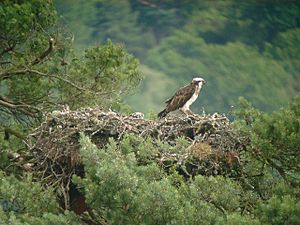Ospreys in Britain facts for kids

The osprey (Pandion haliaetus) is a large raptor. It's known for being a specialist fish-eater. You can find ospreys all over the world. The type of osprey found in Europe and Asia, Pandion haliaetus haliaetus, lives in the British Isles. Here, they are rare breeders, mostly found in Scotland. Smaller numbers also live in England and Wales. Ospreys disappeared from the British Isles in 1916 but came back in 1954. Ospreys from Scandinavia fly through Britain on their way to their breeding grounds.
Contents
Ospreys: A Comeback Story
Ospreys used to live in many parts of Britain. However, they were hunted a lot in the 1800s and early 1900s. People collected their eggs and skins. This caused ospreys to become extinct as breeding birds in England by 1840. It's thought they were gone from Scotland between 1916 and 1954. There's some idea they might have still bred in Strathspey in the 1930s and 40s. They probably didn't live in Wales at this time. In Ireland, they seem to have disappeared in the early 1800s.
How Ospreys Returned
Ospreys Return to Scotland
In 1954, ospreys from Scandinavia naturally started nesting in Scotland again. A pair has successfully nested almost every year since 1959 at the Loch Garten Osprey Centre. This is in the Abernethy Forest Reserve in the Scottish Highlands. The Osprey Centre at Loch Garten is now a very famous conservation spot in the UK. Over 2 million people have visited it since 1959.
At first, the return of ospreys was very slow. This was because of harmful organochlorine pesticides in their food. Also, egg collectors were still a problem. By 1976, there were only 14 breeding pairs. To help protect the birds, "Operation Osprey" was started. Barbed wire and electric fences were put around their nests. People also watched over the nests at night. Fifteen years later, in 1991, the number of pairs grew to 71. In 2001, 158 breeding pairs were found, mostly in Scotland. By 2021, the RSPB estimated there were between 200 and 250 nesting pairs in Great Britain.
Some young ospreys from Scottish nests have been moved. They went to England and Spain (Urdaibai Bird Center) to help start new osprey groups.
Ospreys Reintroduced to England
Ospreys were spreading slowly in Scotland. So, in 1996, English Nature and Scottish Natural Heritage started a project. They wanted to reintroduce ospreys to central England. For six years, young ospreys from Scottish nests were moved. They were released at the Nature Reserve at Rutland Water in the Midlands. Anglian Water provided money for this project. The Leicestershire and Rutland Wildlife Trust managed it with many volunteers.
In 1999, some of these moved birds came back after flying from Africa. In 2001, the first pair bred, including a famous male called Mr Rutland. By 2019, there were 25 ospreys around Rutland Water, with 8 breeding pairs.
Ospreys Return to England and Wales
In 1999, a pair from the Scottish osprey group bred for the first time in the Lake District. This happened at Bassenthwaite Lake.
The project to move ospreys had an unexpected result. Two nests were found in Wales in 2004. One was near Welshpool in Montgomeryshire. The other was at the RSPB Glaslyn Osprey Project at Pont Croesor, near Porthmadog in north Wales. In both cases, the male osprey had been moved from Scotland to Rutland.
In June 2009, a pair had three young at Kielder Forest. These were the first ospreys to breed at Kielder in over 200 years. By 2020, many nests were successfully breeding at Kielder.
In 2011, the Dyfi Osprey Project reported good news. An unringed male osprey and a female from Rutland Water (born in 2008) successfully raised chicks. This was at a new nest site near the river Dyfi in Wales.
In 2012, a new nest was found in Snowdonia, and one chick hatched. Since 2014, ospreys have been nesting successfully near Clywedog Reservoir in Powys. In 2018, a pair nested successfully for the first time at Llyn Brenig.
Protecting Ospreys by Law
Ospreys are a protected species under the Wildlife and Countryside Act 1981. This law makes it illegal to:
- Take or own osprey eggs.
- Harm the birds or their nests.
- Intentionally or carelessly disturb an osprey while it's building a nest.
- Disturb an osprey near a nest with eggs or young.
- Disturb young ospreys that depend on their parents.
Watching and Tracking Ospreys
Many wildlife groups have websites where you can watch live webcams of nesting ospreys. These include sites like Loch Garten, Rutland Water, the Woodland Trust's Loch Arkaig, WWT Caerlaverock, Scottish Wildlife Trust at Loch of the Lowes, and Dyfi. You can usually watch them during the breeding season (April to September).
Loch Garten, Dyfi, and the Highland Foundation for Wildlife have put small satellite trackers on some young ospreys. This helps scientists learn more about how they migrate. The exact locations of many nests are not shared widely. This is to protect the eggs from being stolen by collectors. Even though it's illegal since 1981, egg collecting is still a threat to rare nesting birds.
Ringing Ospreys
Many ospreys can be identified because they have rings on their legs. This is part of a program run by the British Trust for Ornithology (BTO). Ospreys ringed in Britain recently have a metal BTO ring on one leg. They also have a blue "Darvic" ring on the other leg that can be read from a distance. If you see an osprey with a colored ring in the UK, you should report it to the Roy Dennis Wildlife Foundation. They help manage the ringing of ospreys across the country.

